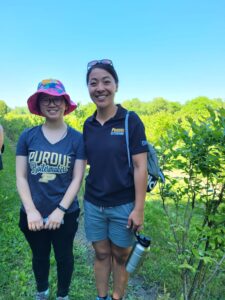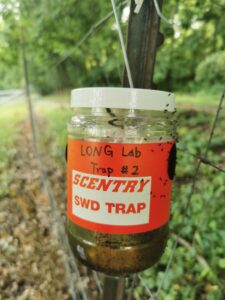Updates on Spotted-wing Drosophila (SWD) activity in Indiana blueberries
Zihan (Lilac) Hong and Elizabeth Y. Long, Purdue Entomology
Summer is a time we always look forward to delicious fresh fruit! According to the 2017 USDA Census of Agriculture, 150+ farms grow some 600 acres of blueberries in Indiana! Some common varieties include Bluecrop, Bluejay, Blueray, Duke, Elliot, Jersey, and Nelson. The typical blueberry season in Indiana runs from late June or early July through August, but this can vary with blueberry variety, and location in the state. Most commercial blueberry plantings are in the northern third of the state where soils are sandy, naturally acid, and high in organic matter. (Figure 1).

Figure 1. Mature and ripening Blueray berries at a blueberry orchard in Tippecanoe County on July 9th. Photo: Zihan Hong.
However, wherever there are delicious fruits, there are also fruit pests: the Spotted-wing Drosophila (SWD) is an invasive vinegar fly that was first detected in the contiguous United States in 2008 and in Indiana in 2012. SWD is one of the most important insect pests to manage in blueberry systems; however, it is also a pest of other small fruits, including raspberries, blackberries, strawberries, cherries, and grapes. Female SWD are unique in that they have a serrated egg-laying organ (ovipositor) (Figure 2), which allows them to cut healthy fruits to lay their eggs. Infested fruits may appear normal and healthy initially, but over time berries will shrink and deform as larvae eat the fruit pulp, eventually causing the berry to collapse.

Figure 2. A 55X-magnified image of the serrated egg-laying organ (ovipositor) of the female Spotted-wing Drosophila. Photo: Zihan Hong.
With the help of collaborating blueberry growers, we placed SWD monitoring traps in three counties in Indiana during the week of May 10th to track SWD seasonal activity and abundance this year (Figure 3).

Figure 3. Master’s student, Zihan (Lilac) Hong, and Dr. Elizabeth Long at the annual Blueberry Growers of Indiana Meeting in June 2021.
SWD monitoring traps (Figure 4) help growers determine when SWD first appear in fruit plantings, as well as how population numbers grow and change over time. SWD monitoring traps, like the commercial Scentry trap, consist of two parts: an attractive bait that draws adult flies into the trap and a drowning solution that collects captured flies. Once adult flies enter, they cannot escape and eventually fall into the drowning solution at the bottom of the trap. A commonly used bait is apple cider vinegar, which is readily available, inexpensive, and both attracts and drowns SWD adults.
These kinds of traps are useful early detection tools when placed in small fruit plantings before berries begin to ripen and can be left in place throughout the production season. To determine if SWD is present and whether the population is growing over time, the drowning solution should be collected weekly and examined with a microscope or magnifying glass to confirm presence of SWD. The current recommendation for SWD management in small fruit systems is to begin insecticide applications when one SWD adult is detected in a monitoring trap and fruits are in the ripening stage.
Our first SWD detection in 2021 occurred on June 25th, and the highest number of SWD adults detected in a trap so far is 43, collected on July 6th. We will keep monitoring blueberry orchards for this invasive insect pest, and in the meantime you can track the most up-to-date SWD trap captures at the Long Horticultural IPM Lab website.

Figure 4. A commercial Scentry Spotted-wing Drosophila trap in the field, with many small flies attracted to the side of the trap. Photo: Zihan Hong.
To further understand SWD seasonal activity, growers can track degree days to predict SWD development based on daily high and low temperatures. Because insect development is temperature dependent, progress from one life stage to the next (for example, the pupa stage to the adult stage) varies depending on daily temperatures. Degree days can be a precise and reliable tool to predict insect pest activity, but a variety of factors, including temperature, humidity, and crop variety, can impact its accuracy. We are working on a SWD degree-day model developed specifically for Indiana blueberry-producing regions, which has the potential to improve the efficacy and timing of IPM strategies against SWD for blueberry growers in our state. We also want to uncover potential relationships between SWD infestation and blueberry qualities, such as variety, sweetness, and firmness.